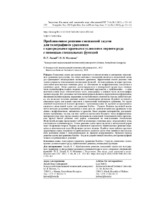Приближенное решение смешанной задачи для телеграфного уравнения с однородными краевыми условиями первого рода с помощью специальных функций

Date
2021Publisher
Another Title
Approximate Solution of Mixed Problem for Telegrapher Equation with Homogeneous Boundary Conditions of First Kind Using Special Functions
Bibliographic entry
Ласый, П. Г. Приближенное решение смешанной задачи для телеграфного уравнения с однородными краевыми условиями первого рода с помощью специальных функций = Approximate Solution of Mixed Problem for Telegrapher Equation with Homogeneous Boundary Conditions of First Kind Using Special Functions / П. Г. Ласый, И. Н. Мелешко // Энергетика. Известия высших учебных заведений и энергетических объединений СНГ. – 2021. – № 2. – С. 152-163.
Abstract
Смешанная задача для хорошо известного в электротехнике и электронике телеграфного уравнения при условии, что линия свободна от искажений, сводится к аналогичной задаче для одномерного неоднородного волнового уравнения. Эффективный способ решения этой задачи основан на использовании специальных функций – полилогарифмов, которые представляют собой комплексные степенные ряды со степенными же коэффициентами, сходящиеся в единичном круге. Точное решение задачи выражается в интегральной форме через мнимую часть полилогарифма первого порядка на единичной окружности, а приближенное – в виде конечной суммы через действительную часть дилогарифма и мнимую часть полилогарифма третьего порядка. Все указанные части полилогарифмов являются периодическими функциями, имеющими полиномиальные выражения соответствующих степеней на отрезке длиной в период, что позволяет получить решение задачи в элементарных функциях. В работе исследуется смешанная задача для хорошо известного в приложениях телеграфного уравнения. Эта задача линейной подстановкой искомой функции с экспоненциальным по времени коэффициентом сводится к аналогичной задаче для уравнения Клейна – Гордона. Решение последней можно найти методом разделения переменных в виде ряда по тригонометрическим функциям точки линии с коэффициентами, зависящими от времени. Такое решение малопригодно для практического применения, так как для него требуется вычисление большого числа коэффициентов - интегралов и при этом трудно оценить погрешность вычислений. В настоящей статье предлагается другой способ решения этой задачи, основанный на использовании специальных He-функций, которые представляют собой комплексные степенные ряды определенного вида, сходящиеся в единичном круге. Точное решение задачи представляется в интегральной форме через He-функции второго порядка на единичной окружности. Приближенное решение выражается в конечном виде через He-функции третьего порядка. В работе также найдена простая и эффективная оценка погрешности приближенного решения задачи. Она линейна относительно шага разбиения линии с экспоненциальным по времени коэффициентом. Приведен пример решения задачи для уравнения Клейна – Гордона разработанным способом, построены графики точного и приближенного решений.
Abstract in another language
The mixed problem for the telegraph equation well-known in electrical engineering and electronics, provided that the line is free from distortions, is reduced to a similar problem for one-dimensional inhomogeneous wave equation. An effective way to solve this problem is based on the use of special functions – polylogarithms, which are complex power series with power coefficients, converging in the unit circle. The exact solution of the problem is expressed in integral form in terms of the imaginary part of the first-order polylogarithm on the unit circle, and the approximate one – in the form of a finite sum in terms of the real part of the dilogarithm and the imaginary part of the third-order polylogarithm. All the indicated parts of the polylogarithms are periodic functions that have polynomial expressions of the corresponding degrees on an interval of length in the period, which makes it possible to obtain a solution to the problem in elementary functions. In the paper, we study a mixed problem for the telegrapher’s equation which is well-known in applications. This problem of linear substitution of the desired function with a time-exponential coefficient is reduced to a similar problem for the Klein – Gordon equation. The solution of the latter can be found by dividing the variables in the form of a series of trigonometric functions of a line point with time-dependent coefficients. Such a solution is of little use for practical application, since it requires the calculation of a large number of coefficients-integrals and it is difficult to estimate the error of calculations. In the present paper, we propose another way to solve this problem, based on the use of special He-functions, which are complex power series of a certain type that converge in the unit circle. The exact solution of the problem is presented in integral form in terms of second-order He-functions on the unit circle. The approximate solution is expressed in the final form in terms of third-order He-functions. The paper also proposes a simple and effective estimate of the error of the approximate solution of the problem. It is linear in relation to the line splitting step with a time-exponential coefficient. An example of solving the problem for the Klein – Gordon equation in the way that has been developed is given, and the graphs of exact and approximate solutions are constructed.
View/
Collections
- № 2[8]
